Abstract
Under operating conditions, metallic particle contaminants inside Gas-Insulated Switchgears (GIS) represent a major threat that can initiate partial discharges (PD) and lead to insulation failure. To investigate the discharge patterns under combined AC and switching impulse voltages, this paper presents an experimental study conducted in SF6 gas on wire-shaped, spherical, and Mixed Metal Particles. By synchronously analyzing PD time-domain waveforms, Phase-Resolved Partial Discharge (PRPD) patterns, and high-speed motion camera recordings, the correlation between particle motion behavior and discharge signals was systematically examined. The results indicate that wire particles exhibit a significant discharge initiation delay under the combined voltage; however, intense, discrete discharges with large magnitudes occur during their vertical jumping phase. In contrast, spherical particles can be activated within the first power frequency cycle without delay, but the subsequent discharge magnitudes are limited. The characteristics of hybrid particles lie between these two types, demonstrating a staged evolution described as “spherical particles lead initiation, wire particles dominate discharge.” Furthermore, under the sustained AC voltage, hybrid particles trigger a more dispersed and violent discharge process. These findings reveal the complex motion-discharge mechanism of Mixed Metal Particles, providing critical insights for fault mechanism analysis and insulation protection related to particle contamination in practical GIS equipment.
1. Introduction
Gas-Insulated Switchgear (GIS) serves as critical equipment in power systems, playing a vital role in power transmission and conversion. Its operational safety is directly linked to the stability and reliability of the power grid. In recent years, statistics from the State Grid Corporation of China indicate that the failure rate of ultra-high voltage and extra-high voltage GIS remains relatively high. In 2024 alone, 17 failures were recorded, 10 of which occurred during switching operations, frequently leading to busbar tripping or DC blockades. Failures triggered by switching operations have thus become a significant factor constraining the safe operation of GIS [1,2,3]. The operational conditions during GIS switching are severe, where mechanical vibrations and electrical transients can activate latent defects, with metallic particle contamination being particularly prominent. Reports suggest that defects related to metallic particles account for approximately 60% of GIS failures, making them a primary cause of insulation degradation [4,5,6].
Consequently, the partial discharge (PD) characteristics initiated by metallic particles have long attracted widespread attention from researchers globally. Early studies primarily focused on the motion patterns and PD characteristics of particles under steady-state DC and AC voltages [7,8,9], exploring the influence of factors like size and shape on their movement behavior and discharge activity [10,11,12]. However, with the accumulation of field experience, it has been recognized that the mechanism behind particle-induced failures in actual GIS often cannot be explained by single steady-state voltage conditions alone. Instead, specific abnormal conditions are typically required to initiate sustained motion and discharge under steady-state voltage, eventually evolving into equipment failure [13,14]. In response, recent research has gradually shifted towards particle behavior under complex stresses, particularly combined with AC voltage. For instance, Shi Tianyi et al. investigated particle motion under the combined influence of AC voltage and mechanical vibration, finding that both transient and steady-state vibrations significantly excite particle movement. Furthermore, sustained vibration can enhance the discharge activity of smaller particles and increase the discharge repetition rate [15,16]. On the other hand, the research team led by Li Junhao focused on the combined AC and impulse voltages encountered during switching operations. They revealed the PD characteristics of particles under AC combined with lightning impulse voltage, noting that particle motion is more readily initiated when a negative lightning impulse superimposes on the negative half-cycle of the AC voltage, leading to enhanced subsequent PD activity [17,18]. Overall, research on metallic particle motion and discharge has expanded from single steady-state voltage conditions to complex operational scenarios and combined stress conditions, providing theoretical support for analyzing and preventing GIS failures in practical operating environments. Deng Jinyi et al. established a simulation model for 110 kV GIS equipment based on finite element simulation, simulating the impact of different shapes and multiple metal particle adhesion defects on the electric field of GIS equipment. The results showed that the electric field distortion at the location of elongated particles increases with their elongation; the electric field distortion is more severe at the sharp corners of spiny particles at an angle of 60°; and the thinner the circular flaky particles, the more severe the electric field distortion [19].
Although existing studies have demonstrated the significant excitatory effect of combined AC and impulse voltage on particle motion and discharge, related research remains exploratory and has limitations. Firstly, current work predominantly concentrates on AC combined with lightning impulse voltage, with insufficient attention paid to AC combined with switching impulse voltage. Secondly, most existing studies utilize spherical or wire-shaped particles of a single morphology. In contrast, particles in actual equipment are often a mixture of various shapes, and research on such complex contaminants remains limited.
Based on this, this paper takes the condition of AC superimposed with switching impulse voltage as the research object and conducts experimental research on the partial discharge characteristics involving a mixture of wire-shaped and spherical metallic particles. Differences between hybrid particles and single-type particles are compared and analyzed. By synchronously observing particle motion behavior and partial discharge signals, the motion-induced discharge mechanism of Mixed Metal Particles under combined voltage is revealed. The findings aim to provide new theoretical references for defect diagnosis and enhancing the operational reliability of GIS under complex working conditions.
2. Experimental Setup
2.1. AC-Switching Impulse Combined Voltage Test System
For the specific condition of AC combined with switching impulse voltage, the experimental setup established is illustrated in Figure 1. The setup comprises an AC test system, a switching impulse voltage circuit with a rated voltage of 100 kV, a sphere-gap synchronous triggering system, a partial discharge measurement circuit, and protective devices. The phase-shift triggering system acquires the voltage signal across the test object via a capacitive divider (C2). Utilizing a control module and optical fibers, it synchronously triggers the main sphere gap (g1) and the isolation/protection sphere gap (g2). Nanosecond-level synchronous timing control technology ensures the simultaneous operation of the two sphere gaps, thereby guaranteeing phase consistency and reliability of the voltage waveform superimposed at the defective end.
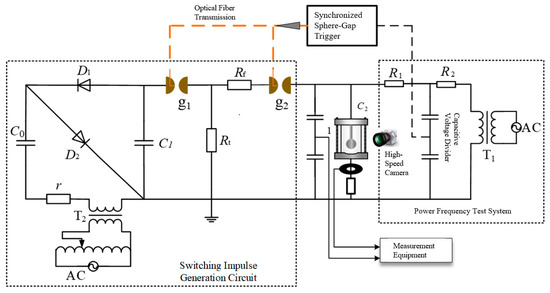
Figure 1.
The AC and switching impulse superposition experiment platform.
The constructed partial discharge (PD) detection system consists of a high-frequency current transformer (HFCT), a partial discharge detector (DDX 9121b, Ruixuan Electronic Technology Co., Ltd., Shanghai, China), and a high-resolution digital oscilloscope (Tektronix HDO 9104, TeledyneLeCroy, New York, NY, USA). For detecting PD from metallic particles under the combined voltage, the HFCT (frequency range: 800 kHz to 102 MHz) coupled with the HDO 9104 oscilloscope was primarily used, while the PD detector was simultaneously employed to record Phase-Resolved Partial Discharge (PRPD) patterns.
The experiment utilized a phase-shift trigger to control the phase angle at which the switching impulse voltage was superimposed onto the AC voltage waveform. This enabled precise superposition of the impulse at different predefined phases of the AC cycle. Figure 2 shows the resulting voltage waveform output by the experimental platform, demonstrating a switching impulse successfully superimposed at the 270-degree point of the AC voltage cycle.
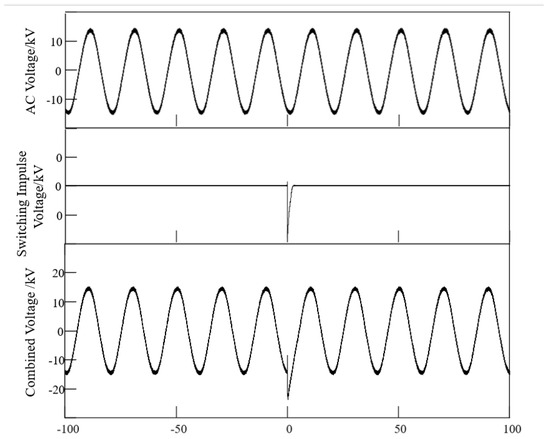
Figure 2.
AC superposition switching impulse voltage waveform.
2.2. Metallic Particle Defect Model
Based on the dimensional proportions of internal components within a 252 kV GIS coaxial cylindrical electrode, a metallic particle defect model was designed, as illustrated in Figure 3. The upper electrode is an aluminum electrode with a radius of 17 mm, while a concentric grounded aluminum spherical-base electrode (base radius of 46 mm) is configured at the bottom. By controlling the electric field distribution, the field non-uniformity factor is maintained at 1.54, effectively replicating the quasi-uniform electric field characteristics of an actual GIS coaxial cylindrical electrode.
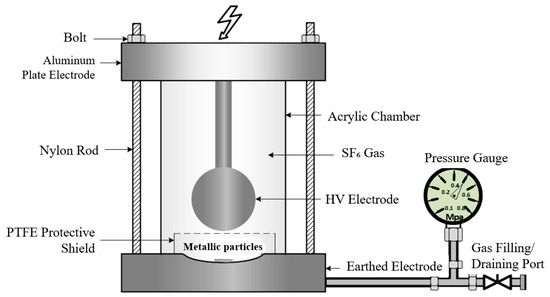
Figure 3.
Metal particle defect test model.
To thoroughly analyze the partial discharge characteristics of Mixed Metal Particles, this study selected wire-shaped particles, known for causing the most severe electric field distortion and posing the greatest threat to insulation integrity, and combined them with representative spherical metallic particles for investigation. The wire-shaped particles had dimensions of 0.4 mm in diameter and 1 mm in length, while the spherical particles had a diameter of 1.5 mm. All the metal particles mentioned in the article are made of aluminum.
2.3. Correlative Analysis System for Partial Discharge Detection and Motion Capture
To correlate the discharge characteristics of metallic particles with their motion under combined AC and switching impulse voltage, a synchronized analysis system for partial discharge detection and motion capture was designed, as shown in Figure 4. The particle motion capture system employs a high-speed camera(High-Speed Camera M230M/C from Hefei Zhongke Junda Vision Technologies Co., Ltd., Hefei, China) with supplemental lighting. This camera can capture up to 3000 frames per second at a resolution of 1920 × 1080, achieving a temporal resolution of 0.3 ms, which meets the requirement for precise tracking of particle motion. The high-speed camera is externally triggered by the oscilloscope, ensuring synchronization between the application of the combined AC-switching impulse voltage and the image acquisition. This enables the simultaneous capture of partial discharge signals and particle motion behavior. By comparing the time-domain PD signals following the switching impulse with the corresponding transient frame images from the motion capture system, the correlation between specific discharge events and particle motion is established, allowing for a coupled analysis of motion behavior and partial discharge characteristics.
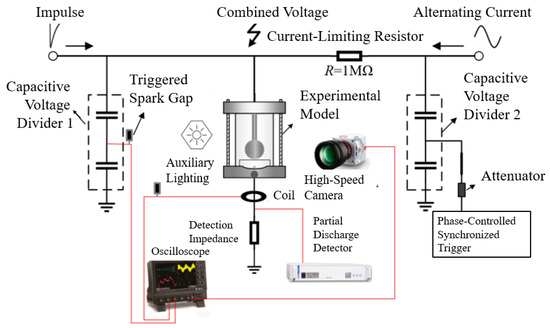
Figure 4.
Partial discharge detection and motion capture correlation analysis system.
2.4. Experimental Methodology
The experiments on metallic particles under combined AC and switching impulse voltage were conducted in two stages: (1) measurement of the Partial Discharge Inception Voltage (PDIV), and (2) synchronized detection of discharge characteristics and motion behavior of metallic particles under the superimposed switching impulse voltage.
After determining the PDIV, the AC voltage was set to 95% of the PDIV, and a standard switching impulse with a peak value of 2 times the PDIV was applied to the defect. This was performed to investigate the excitatory effect of the superimposed impulse on the subsequent partial discharge activity of the particles. During the experiments, while the pulse current method was used to acquire the time-domain PD signals, the high-speed camera was externally triggered to capture the motion characteristics of the metallic particles. The experimental results were analyzed by comparing the state of the metallic particles before and after the application of the switching impulse voltage.
3. Partial Discharge Characteristics of Single-Type Metallic Particles Under Combined Voltage
3.1. Partial Discharge Characteristics of a Single Wire-Shaped Particle
Under AC voltage alone, the PDIV for the wire-shaped particle was 9.5 kV. Following the experimental procedure, a 19 kV switching impulse was superimposed onto a 9 kV AC background voltage (below the PDIV). The resulting time-domain PD waveform is shown in Figure 5. The experimental results indicate that no PD signals were detected when only the AC voltage below the inception level was applied. However, after the application of the switching impulse, sustained PD activity appeared in the subsequent AC cycles. A noticeable delay (Δt) of approximately 7 AC cycles was observed between the application of the switching impulse and the emergence of significant PD signals.
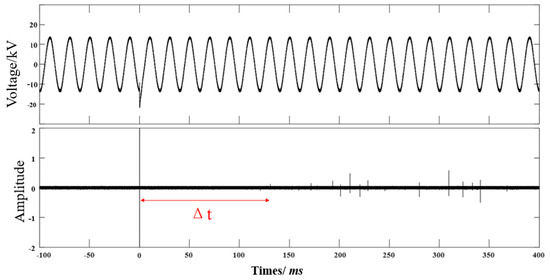
Figure 5.
Partial discharge signals of linear particles under the impulse voltage of AC superposition switching.
Furthermore, the motion process of the wire-shaped particle was captured using the high-speed camera to observe its movement characteristics and discharge behavior following the application of the combined AC and switching impulse voltage. The experiments revealed that the excited motion of a single wire-shaped particle can be divided into two distinct stages.
In the first stage, initially excited by the transient switching impulse, the particle exhibited a slight lift-off at its end with the larger radius of curvature within approximately 1 ms. Subsequently, the entire particle entered a “seesaw-like” motion, as shown in Figure 6a. The positions indicated by the arrows in the figure represent the lifted and fallen ends of the metal particles. In this mode, one end of the particle rises while the other end falls, forming a reciprocating alternating lifting motion. The middle part remains relatively fixed, and when one end rises, the lifting angle changes between 0 and 90 degrees. In this mode, one end of the particle lifts while the opposite end descends, creating a reciprocating, alternating lifting motion with the central part remaining relatively fixed, resembling the action of a seesaw.
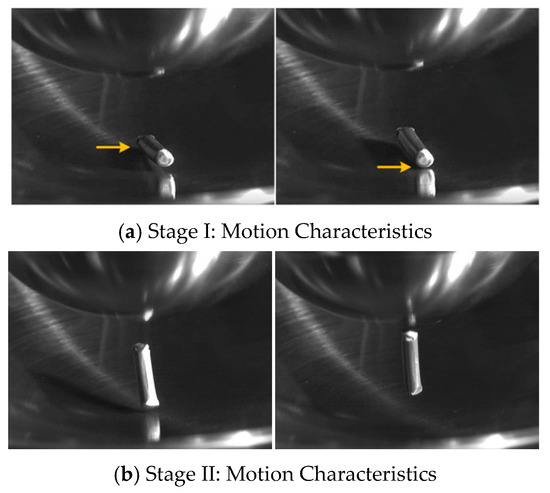
Figure 6.
Motion characteristics of linear particles.
Upon transitioning to the second stage, the lift-off height at both ends of the particle gradually increased. Eventually, the end with the larger radius of curvature, experiencing a stronger electric field distortion, was vertically launched. At this point, the particle adopted a motion pattern characterized by vertical, reciprocating jumps accompanied by rotation, as illustrated in Figure 6b. During this process, the particle sometimes landed and then lifted off again, re-entering the vertical jumping state.
It is noteworthy that the motion amplitude in the first stage was relatively small and insufficient to initiate measurable partial discharge signals. In contrast, significant PD activity was gradually excited during the second stage, coinciding with the intensified motion and enhanced electric field distortion. This evolutionary process corresponds precisely to the time delay (Δt) observed in Figure 5, explaining the approximately 7 AC cycles required between the voltage application and the emergence of observable PD signals.
Under the subsequent AC voltage, sustained discharge activity was observed via the partial discharge detector, with its phase distribution characteristics shown in Figure 7. The Phase-Resolved Partial Discharge (PRPD) pattern indicates that the partial discharges initiated by the wire-shaped particle not only exhibit the typical feature of metallic particle discharges distributed across the entire AC cycle but are also accompanied by discrete, large-magnitude discharge pulses. These discrete discharges primarily originate from transient discharge signals excited when the wire particle jumps towards and makes contact with (or approaches) the high-voltage electrode during its motion. Consequently, wire-shaped metallic particles often demonstrate stronger discharge activity and pose a greater potential hazard in practical operation. Such high-magnitude discharges are more likely to initiate insulation breakdown or flashover, presenting a serious threat to equipment operational safety.
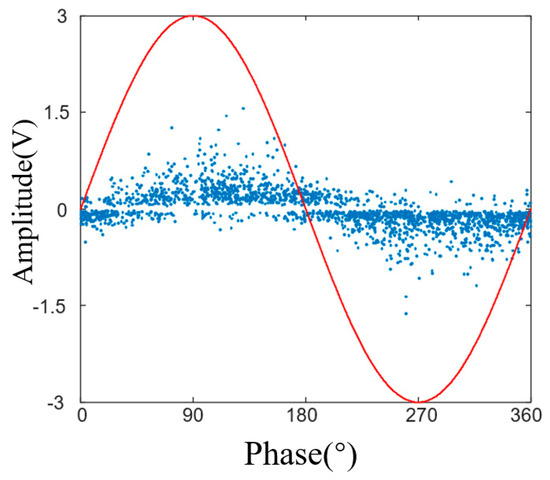
Figure 7.
PRPD pattern of line particles under superimposed switching impulse.
3.2. Partial Discharge Characteristics of a Single Spherical Metallic Particle
The PDIV for the spherical metallic particle under AC voltage was 7.6 kV, which is lower than that of the wire-shaped particle. The time-domain waveform obtained after applying a 7.2 kV AC voltage superimposed with a 15.2 kV switching impulse voltage (i.e., 2 times PDIV) is shown in Figure 8. In contrast to the wire-shaped particle, the spherical particle generated significant partial discharge signals within the first AC cycle following the superimposed impulse, exhibiting no observable time delay phenomenon as seen in Figure 5.
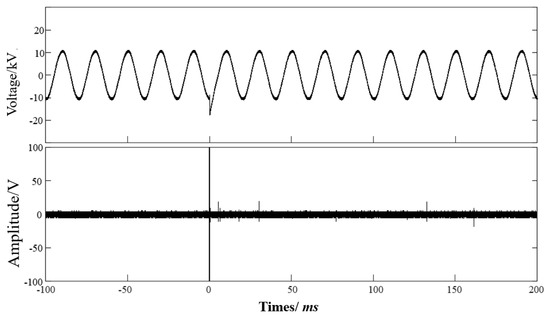
Figure 8.
Partial discharge signals of circular particles under the impulse voltage of AC superposition switching.
Furthermore, as shown in Figure 9, synchronous observation of its motion behavior revealed that the spherical particle rapidly gains energy under the combined voltage and begins to bounce significantly. Subsequently, it triggers continuous discharge signals during this bouncing motion, which explains the absence of a discharge delay. This indicates that, compared to the wire-shaped particle, the spherical particle is more readily excited and can initiate partial discharge more rapidly under the combined AC and switching impulse voltage condition.

Figure 9.
Motion characteristics of circular particles.
However, regarding the subsequent discharge behavior, the discharge intensity of the spherical particle was significantly weaker. As shown in Figure 10, the Phase-Resolved Partial Discharge (PRPD) pattern acquired under the AC voltage shows that while the discharges are distributed across the entire phase cycle, no discrete, large-magnitude discharge pulses are present. This is attributed to the limited electric field distortion caused by the spherical particle during its motion, which prevents significant energy accumulation. Furthermore, the bouncing amplitude is insufficient for the particle to reach (or closely approach) the high-voltage electrode, thus failing to generate the intense discharge activity observed with the wire-shaped particle.
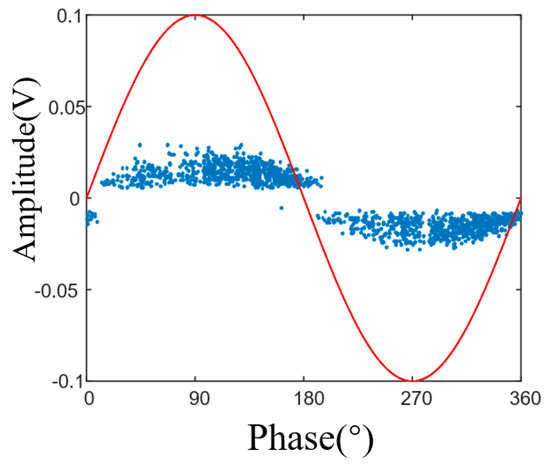
Figure 10.
PRPD pattern of circular particles under superimposed switching impulse.
In summary, significant differences exist in the partial discharge characteristics between wire-shaped and spherical metallic particles under combined AC and switching impulse voltage: spherical particles are more readily excited and initiate discharge rapidly after the impulse, but their limited motion amplitude and weaker electric field distortion result in lower subsequent discharge intensity. In contrast, although the discharge initiation of wire-shaped particles exhibits a time delay, once they enter the vertical jumping phase, their discharge activity becomes more intense, often accompanied by large-magnitude discrete discharges, thereby posing a greater threat to the insulation safety of the equipment.
4. Partial Discharge Characteristics of Mixed Metal Particles Under Combined Voltage
Experiments were conducted by combining the previously studied spherical and wire-shaped metallic particles. The results show that the PDIV for the hybrid particles under AC voltage is 8.6 kV, which lies between that of the single spherical particle (7.6 kV) and the single wire-shaped particle (9.5 kV). This result suggests that the hybrid particle configuration has a certain homogenizing effect on the electric field distribution.
After applying an 8.1 kV AC voltage superimposed with a 17.2 kV switching impulse voltage, the obtained time-domain PD waveform is shown in Figure 11. It can be observed that in the initial stage following the superimposed impulse, PD signals of relatively small amplitude (not exceeding 50 mV) appear first, lasting approximately 450 ms, as shown in Figure 11. Subsequently, the discharge signals gradually intensify, with pulses reaching amplitudes up to about 150 mV. This result indicates that the partial discharge under the influence of Mixed Metal Particles exhibits an evolutionary process from weak to strong, demonstrating a unique transitional discharge characteristic. The hybrid particles inherit the ease of excitation under combined voltage seen in spherical particles, while also exhibiting a trend of intensified discharge in the later stage, similar to wire-shaped particles.
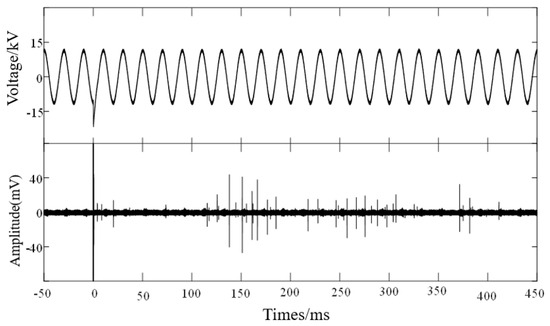
Figure 11.
Partial discharge signals of mixed metallic particles under power-frequency superimposed operating impulse voltage.
The reason for these discharge characteristics lies in the more complex motion behavior of the Mixed Metal Particles. By synchronously observing the PD signals and particle motion, a clear correlation between the motion process and discharge features can be established. After the combined voltage is applied, the spherical particle jumps first while the wire-shaped particle remains stationary, as shown in Figure 12a. The yellow arrow shows spherical metal particles leaping from the stationary ground electrode into the air. Subsequently, as the spherical particle fully lifts off and collides with the wire-shaped particle (Figure 12b), the wire-shaped particle is excited into the “seesaw-like” motion stage; however, the overall discharge amplitude remains relatively small at this point. This process corresponds to the initial low-amplitude discharge stage. Further, with continued inter-particle collisions and the gradual lifting and eventual vertical jumping of the wire-shaped particle (Figure 12c), the discharge amplitude increases significantly, superimposed with smaller discharge signals generated by the spherical particle. Therefore, the discharge evolution of the hybrid particles exhibits a characteristic of “spherical particles lead the initiation, wire-shaped particles dominate the discharge”.
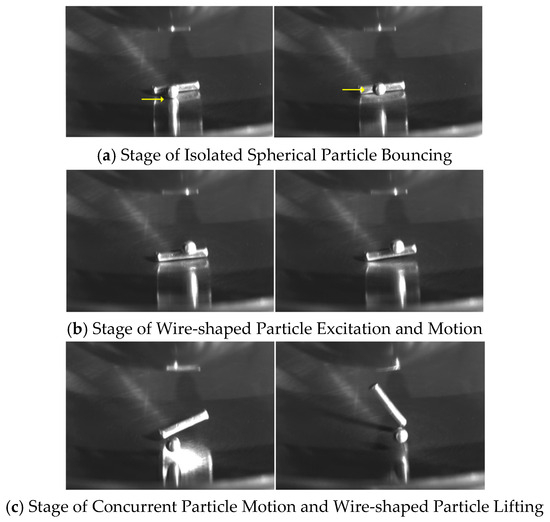
Figure 12.
Motion characteristics of mixed metallic particles.
Under the subsequent sustained AC voltage, the obtained PRPD pattern for the Mixed Metal Particles is shown in Figure 13. Compared to the discharge characteristics of single-type particles, the discharge distribution of the hybrid particles is more dispersed, not only spanning the entire AC phase but also accompanied by a large number of high-amplitude discharge pulses. This indicates that under sustained voltage, the interaction between spherical and linear particles significantly enhances discharge activity, and the reasons behind this are diverse, including mechanical collisions, electromagnetic energy exchange, and so on, which lead to more intense and complex partial discharge processes. This indicates that under sustained voltage, the interaction between the spherical and wire-shaped particles significantly enhances the discharge activity, leading to a more intense and complex partial discharge process.
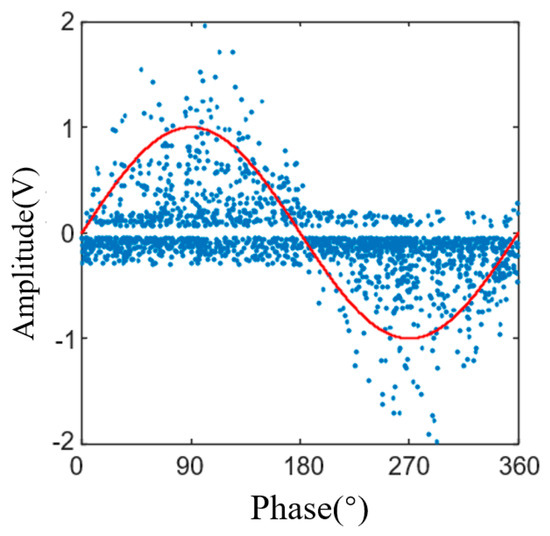
Figure 13.
PRPD patterns of mixed metallic particles under superimposed operating impulse.
5. Conclusions
This paper investigated the partial discharge characteristics of wire-shaped, spherical, and Mixed Metal Particles in SF6 gas under combined AC and switching impulse voltage. The main conclusions are as follows:
- (1)
- The switching impulse voltage can excite latent metallic particle motion under AC voltage and induce partial discharge. Wire-shaped particles exhibit a significant discharge initiation delay under the combined voltage; however, once they enter the vertical jumping stage, the discharge intensity increases rapidly and is often accompanied by large-magnitude discrete discharges. Spherical particles, in contrast, can be excited within the first AC cycle after the impulse without delay, but due to a weaker electric field distortion, their subsequent discharge amplitude is limited, without intense large-magnitude pulses.
- (2)
- Hybrid particles exhibit a staged evolution characteristic under the combined voltage: initially, the spherical particle jumps and triggers low-amplitude discharges; subsequently, collisions from the spherical particle excite the wire-shaped particle into “seesaw-like” and vertical motion, leading to a significant increase in discharge amplitude. Ultimately, a more dispersed PRPD pattern accompanied by numerous large-amplitude pulses is observed, demonstrating the typical characteristic of “spherical particles lead initiation, wire-shaped particles dominate discharge”, maintaining a more intense discharge state under the subsequent AC voltage.
- (3)
- This study reveals the synergistic mechanism of power frequency voltage and switching impulse in triggering partial discharge: power frequency voltage (even if below the threshold) provides a “pre-excitation” field and charge preparation for discharge, while switching impulse plays a crucial “trigger” role by injecting high energy to drastically change the spatial charge distribution, thereby significantly reducing the threshold of subsequent power frequency discharge. Linear particles, due to their significant geometric asymmetry (tip effect), are the core cause of strong electric field distortion and delayed intense discharge. The study infers that an increase in the amplitude of the switching impulse accelerates this triggering process and shortens the discharge delay time. This mechanism indicates that in actual GIS operation, the risk of transient overvoltage “activating” latent metal particle defects is far more lethal than that of steady-state AC voltage itself.
Compared to single-type particles, hybrid particles are more commonly found in practical GIS interiors. The findings of this study indicate that Linear particles exhibit significant discharge triggering delay under superimposed voltage, but strong, discrete, large-amplitude discharge occurs during the vertical jump phase; spherical particles can be excited in the first power frequency cycle without any delay in discharge, especially under complex combined voltage conditions, exhibiting characteristics of being easily excited and producing high-amplitude discharges. The threat posed by complex contaminant combinations to GIS insulation safety is significantly higher than that from single contaminants.
Author Contributions
J.R.: funding acquisition, data curation, formal analysis; Y.M.: data curation; Q.Q.: formal analysis; Z.W.: investigation; Y.W.: methodology; L.W.: writing—original draft preparation; X.H.: writing—review and editing; X.Y.: validation. All authors have read and agreed to the published version of the manuscript.
Funding
This research was funded by Science and Technology Project of State Grid Qinghai Electric Power Company, grant number 522807240001. And the APC was funded by Science and Technology Project of State Grid Qinghai Electric Power Company.
Data Availability Statement
The raw data supporting the conclusions of this article will be made available by the authors on request.
Conflicts of Interest
Authors Jiyun Ren, Yongfu Ma, Quanlei Qu, Zile Wang, Lili Wang and Xiaojie Yang were employed by the State Grid Qinghai Electric Power Research Institute. The remaining authors declare that the research was conducted in the absence of any commercial or financial relationships that could be construed as a potential conflict of interest.
References
- Song, X.; Shao, M. Health Assessment Method for Gas-Insulated Switchgear Based on Fault Tree Analysis. In Proceedings of the 2025 IEEE 3rd International Conference on Power Science and Technology (ICPST), Kunming, China, 16–18 May 2025. [Google Scholar]
- Lu, W.; Yang, H.; Zhang, J.; Yang, C.; Wang, Y.; Wang, Z. Review on Mechanism and Suppression Strategies of Surface Flashover Induced by Metal Particles in DC GIS/GIL. High Volt. Eng. 2025, 51, 1010–1024. [Google Scholar]
- Li, J.; Han, X.; Liu, Z.; Li, Y. Review of Partial Discharge Detection Techniques for Electrical Equipment. High Volt. Eng. 2015, 41, 2583–2601. [Google Scholar]
- Jin, Z.; Du, B.; Xiao, M.; Liang, H.; Yao, H.; Zhang, W. Optimization of Permittivity Graded Spacer for Suppressing Metal Particles in AC-GIS. In Proceedings of the 2025 IEEE 5th International Conference on Electrical Materials and Power Equipment (ICEMPE), Harbin, China, 3–6 August 2025; pp. 1–4. [Google Scholar]
- Ji, H.; Li, C.; Pang, Z.; Ma, G.; Cui, X.; Zeng, Z.; Rong, Z. Moving behaviors and harmfulness analysis of multiple linear metal particles in GIS. IEEE Trans. Dielectr. Electr. Insul. 2016, 23, 3355–3363. [Google Scholar] [CrossRef]
- Li, Y.; Peng, Z.; Chen, C.; Xu, D.; Su, Y.; Lei, Y.; Li, Q. Influence of metal particles with different morphologies on the electric field distribution and discharge characteristics of basin-type insulators in GIS. In Proceedings of the 2025 10th Asia Conference on Power and Electrical Engineering (ACPEE), Beijing, China, 15–19 April 2025; pp. 2737–2741. [Google Scholar]
- Zhang, C.; Li, W.; Yang, X.; Li, M.; Wang, M.; Luo, L. Digital Deduction Method for Metal Particle Size in Gas Insulated Metal-enclosed Switchgear. J. Shanghai Jiaotong Univ. 2025, 1–20. [Google Scholar] [CrossRef]
- Hu, Z. Flying Motion and Discharge Characteristics of Linear Particle Swarm and Cooperative Suppression Methods. Master’s Thesis, North China Electric Power University, Beijing, China, 2024. [Google Scholar]
- Sha, W.; Luo, Y.; Ma, P.; Qi, L. Research on Surface Discharge and Electric Field Characteristics of GIS Basin Insulator under Different Metal Particle Defects. Insul. Mater. 2023, 56, 89–93. [Google Scholar]
- Li, X.; Hu, X.; Xu, H.; Jiang, P.; Wu, M.; Niu, B.; Li, Z.; Zhang, Q. Multi-Particle-in-Series Phenomenon and Discharge Properties Induced by Multiple Free Particles in GIS. IEEE Trans. Power Deliv. 2023, 38, 4039–4048. [Google Scholar] [CrossRef]
- Ma, F.; Niu, B.; Zhang, T.; Tian, Y.; Cao, W. Study on the Motion Process of Foreign Metal Particles in GIS under High Voltage. High Volt. Appar. 2021, 57, 35–41. [Google Scholar]
- Ji, H. Motion Behavior and Discharge Characteristics of Metal Particles in GIS Under AC Operating Voltage. Ph.D. Thesis, North China Electric Power University, Beijing, China, 2017. [Google Scholar]
- Hu, X.; Li, X.; Wang, S.; Li, Z.; Hao, Y.; Zhang, Q. Motion of Free Metal Particles in GIS under Impact Vibration Excitation and Characteristics of Induced Gap Breakdown. High Volt. Eng. 2024, 50, 339–347. [Google Scholar]
- Song, Y.; Zheng, Z.; Yu, J.; Sun, Y.; Zhang, S.Y.; Hou, J.C.; Wang, H.T.; Han, X.T.; Li, J.H. Study on Motion Behavior and Partial Discharge Characteristics of Metal Particles in SF6 Gas under Electro-Mechanical Combined Action. J. Xi’an Jiaotong Univ. 2023, 57, 74–83. [Google Scholar]
- Shi, T.; Zhang, Z.; Li, L.; Huang, H.; Niu, B.; Han, X.; Zhang, X.; Yao, C.; Li, J. Movement Behavior and Discharge Characteristics of Submillimeter Metal Particles Under AC Voltages Superimposed Mechanical Vibration. IEEE Trans. Dielectr. Electr. Insul. 2024, 32, 2460–2468. [Google Scholar] [CrossRef]
- Niu, B.; Bai, T.; Shi, T.; Wu, X.; Han, X.; Liu, W. Initial Characteristics of Submillimeter Metal Particles in GIS under Impact Vibration. Energies 2024, 17, 5100. [Google Scholar] [CrossRef]
- Liu, H.; Han, W.; Fan, Z.; Sun, J.; Qin, W.; Liao, X.; Wang, S.; Ma, G. Acoustic Emission and Propagation Characteristics of Metal Particles in GIS. IEEE Trans. Dielectr. Electr. Insul. 2025, 32, 20–27. [Google Scholar] [CrossRef]
- Han, X.; Wu, X.; Zhao, Y.; Niu, B.; Wang, H.; Li, J. Partial Discharge and Motion Characteristics of Linear Metal Particles in SF6 under AC Superimposed Lightning Impulse Voltage. High Volt. Eng. 2024, 50, 5406–5414. [Google Scholar]
- Deng, J.; Gao, K.; Ren, M.; Huang, H.; Jin, L. Electric field analysis of different forms of metal particle adhesion defects in 110 kV GIS. J. Electr. Eng. 2024, 19, 316–324. [Google Scholar]
Disclaimer/Publisher’s Note: The statements, opinions and data contained in all publications are solely those of the individual author(s) and contributor(s) and not of MDPI and/or the editor(s). MDPI and/or the editor(s) disclaim responsibility for any injury to people or property resulting from any ideas, methods, instructions or products referred to in the content. |
© 2025 by the authors. Licensee MDPI, Basel, Switzerland. This article is an open access article distributed under the terms and conditions of the Creative Commons Attribution (CC BY) license (https://creativecommons.org/licenses/by/4.0/).